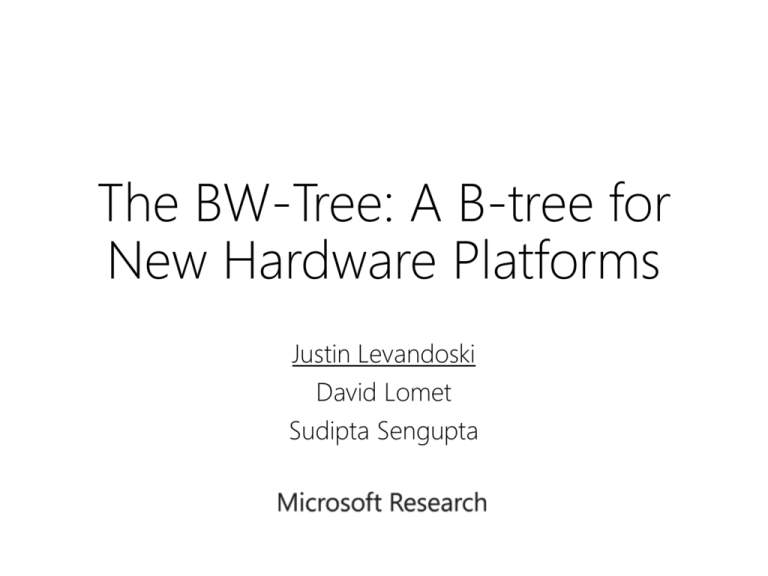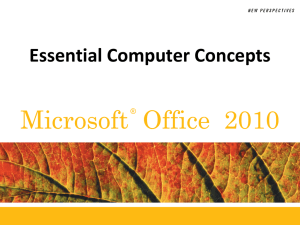BW-tree - Microsoft Research
advertisement

The BW-Tree: A B-tree for New Hardware Platforms Justin Levandoski David Lomet Sudipta Sengupta An Alternate Title “The BW-Tree: A Latch-free, Logstructured B-tree for Multi-core Machines with Large Main Memories and Flash Storage” BW = “Buzz Word” The Buzz Words (1) • B-tree • • • • Key-ordered access to records Efficient point and range lookups Self balancing B-link variant (side pointers at each level) In Memory data data data … data data data On Disk The Buzz Words (2) • Multi-core + large main memories • Latch (lock) free • Worker threads do not set latches for any reason • Threads never block • No data partitioning • “Delta” updates • No updates in place • Reduces cache invalidation • Flash storage • • • • Good at random reads and sequential reads/writes Bad at random writes Use flash as append log Implement novel log-structured storage layer over flash Outline • Overview • Deployment scenarios • Latch-free main-memory index (Hekaton) • Deuteronomy • Bw-tree architecture • In-memory latch-free pages • Latch-free structure modifications • Cache management • Performance highlights • Conclusion Multiple Deployment Scenarios • Standalone (highly concurrent) atomic record store • Fast in-memory, latch-free B-tree • Data component (DC) in a decoupled “Deuteronomy” style transactional system Microsoft SQL Server Hekaton • Main-memory optimized OLTP engine • Engine is completely latch-free • Multi-versioned, optimistic concurrency control (VLDB 2012) • Bw-tree is the ordered index in Hekaton http://research.microsoft.com/main-memory_dbs/ Deuteronomy Client Request Interaction Contract Transaction Component (TC) 1. Guarantee ACID Properties 2. No knowledge of physical data storage Logical locking and logging Control Operations Record Operations Data Component (DC) 1. Physical data storage 2. Atomic record modifications 3. Data could be anywhere (cloud/local) 1. Reliable messaging 2. Idempotence 3. 4. “At least once execution” multiple sends “At most once execution” LSNs Causality “If DC remembers message, TC must also” Write ahead log (WAL) protocol Contract termination “Mechanism to release contract” Checkpointing Storage http://research.microsoft.com/deuteronomy/ Outline • • • • • • • • Overview Deployment scenarios Bw-tree architecture In-memory latch-free pages Latch-free structure modifications Cache management Performance highlights Conclusion Bw-Tree Architecture Focus of this talk B-Tree Layer Cache Layer Flash • • • API B-tree search/update logic In-memory pages only • Logical page abstraction for B-tree layer Brings pages from flash to RAM as necessary • • Layer • Sequential writes to logstructured storage Flash garbage collection Outline • • • • • • • • Overview Deployment scenarios Bw-tree architecture In-memory latch-free pages Latch-free structure modifications Cache management Performance highlights Conclusion Mapping Table and Logical Pages Mapping Table PID Physical Address Index page In-Memory Index page Data page Data page On Flash flash/mem flag address 1 bit 63 bits • Pages are logical, identified by mapping table index • Mapping table • Translates logical page ID to physical address • Important for latch-free behavior and log-structuring • Isolates update to a single page Compare and Swap • Atomic instruction that compares contents of a memory location M to a given value V • If values are equal, installs new given value V’ in M • Otherwise operation fails Address New Value M 30 20 CompareAndSwap(&M, 20, 40) 30) Compare Value X Delta Updates Mapping Table PID Physical Address Δ: Delete record 48 Δ: Insert record 50 P Page P • Each update to a page produces a new address (the delta) • Delta physically points to existing “root” of the page • Install delta address in physical address slot of mapping table using compare and swap Update Contention Δ: Update record 35 Δ: Insert Record 60 Mapping Table PID Physical Address Δ: Delete record 48 Δ: Insert record 50 P Page P • Worker threads may try to install updates to same state of the page • Winner succeeds, any losers must retry • Retry protocol is operation-specific (details in paper) Delta Types • Delta method used to describe all updates to a page • Record update deltas • Insert/Delete/Update of record on a page • Structure modification deltas • Split/Merge information • Flush deltas • Describes what part of the page is on log-structured storage on flash In-Memory Page Consolidation Δ: Update record 35 Mapping Table PID Physical Address Δ: Delete record 48 Δ: Insert record 50 P Page P “Consolidated” Page P • Delta chain eventually degrades search performance • We eventually consolidate updates by creating/installing new search-optimized page with deltas applied • Consolidation piggybacked onto regular operations • Old page state becomes garbage 17 Garbage Collection Using Epochs • Thread joins an epoch prior to each operation (e.g., insert) • Always posts “garbage” to list for current epoch (not necessarily the one it joined) • Garbage for an epoch reclaimed only when all threads have exited the epoch (i.e., the epoch drains) Current Epoch Epoch 1 Members Thread 1 Epoch 2 Members Thread 3 Thread 2 Garbage Collection List Δ Δ Garbage Collection List Δ Δ Δ Δ Δ Outline • • • • • • • • Overview Deployment scenarios Bw-tree architecture In-memory latch-free pages Latch-free structure modifications Cache management Performance highlights Conclusion Latch-Free Node Splits Index Entry Δ Mapping Table PID Physical Address Split Δ Page 1 Page 3 Page 2 Page 4 2 Logical pointer 4 Physical pointer • Page sizes are elastic • No hard physical threshold for splitting • Can split when convenient • B-link structure allows us to “half-split” without latching 1. 2. Install split at child level by creating new page Install new separator key and pointer at parent level Outline • • • • • • • • Overview Deployment scenarios Bw-tree architecture In-memory latch-free pages Latch-free structure modifications Cache management Performance highlights Conclusion Cache Management • Write sequentially to log-structured store using large write buffers • Page marshalling • Transforms in-memory page state to representation written to flush buffer • Ensures correct ordering • Incremental flushing • Usually only flush deltas since last flush • Increased writing efficiency Representation on LSS Sequential log Mapping table Base page Base page -record . . . RAM Base page . . . -record -record Flash Memory Write ordering in log Outline • • • • • • • • Overview Deployment scenarios Bw-tree architecture In-memory latch-free pages Latch-free structure modifications Cache management Performance highlights Conclusion Performance Highlights - Setup • Experimented against • BerkeleyDB standalone B-tree (no transactions) • Latch-free skiplist implementation • Workloads • Xbox • 27M get/set operations from Xbox Live Primetime • 94 byte keys, 1200 byte payloads, read-write ratio of 7:1 • Storage Deduplication • 27M deduplication chunks from real enterprise trace • 20-byte keys (SHA-1 hash), 44-byte payload, read-write ratio of 2.2:1 • Synthetic • 42M operations with keys randomly generated • 8-byte keys, 8-byte payloads, read-write ratio of 5:1 Vs. BerkeleyDB BW-Tree BerkeleyDB 12.0 Operations/Sec (M) 10.40 10.0 8.0 6.0 3.83 4.0 2.0 2.84 0.56 0.66 0.33 0.0 Xbox Synthetic Deduplication Vs. Skiplists Synthetic workload L1 hits Bw-Tree Skiplist 3.83M Ops/Sec 1.02 M Ops/Sec L2 hits L3 hits RAM 100% 90% 80% 70% 60% 50% 40% 30% 20% 10% 0% Bw-tree Skiplist Outline • • • • • • • • Overview Deployment scenarios Bw-tree architecture In-memory latch-free pages Latch-free structure modifications Cache management Performance highlights Conclusion Conclusion • Introduced a high performance B-tree • Latch free • Install delta updates with CAS (do not update in place) • Mapping table isolates address change to single page • Log structured (details in another paper) • Uses flash as append log • Updates batched and written sequentially • Flush queue maintains ordering • Very good performance Questions?







